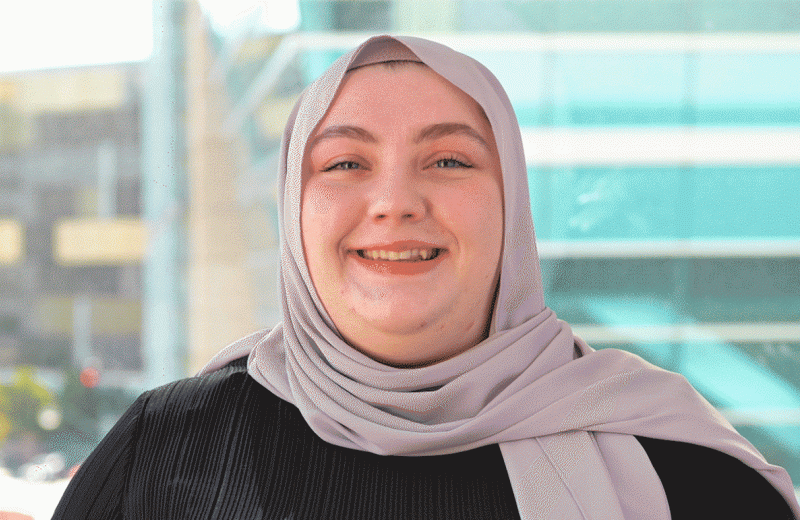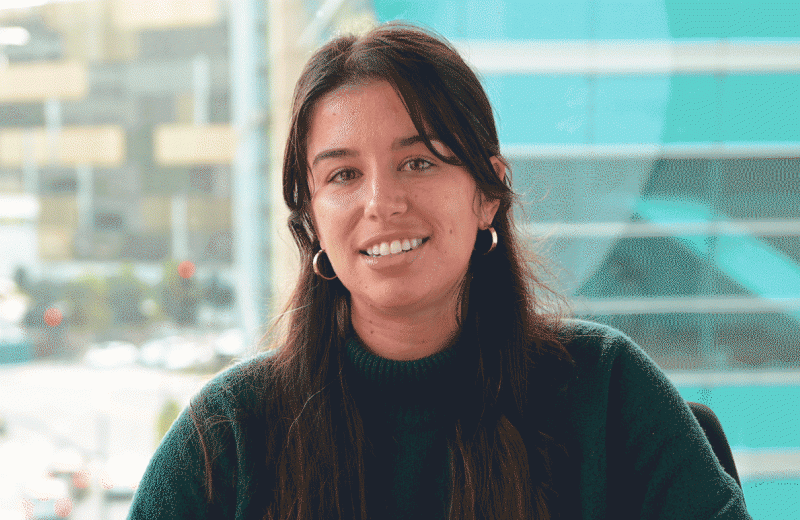
Shannon Noonan, MS, is the program manager for diversity, outreach, and mentoring efforts at the Gladstone Institutes. She joined Gladstone in 2010 after working in student academic affairs at the University of California, San Francisco. She has a master’s degree in counseling from San Francisco State University. [Photo: Chris Goodfellow, Gladstone Institutes]
What brought you to Gladstone?
In 2010, I was working at UCSF as a student academic affairs officer for the Center for Education Partnerships. I did science outreach for K–12 students at local public schools in San Francisco. One of the high schools I worked at, Burton High School in the Bayview/Hunter’s Point neighborhood, needed to take an annual field trip to a local university. I picked UCSF Mission Bay and brought 50 students interested in science careers to Gladstone. I worked directly with Kathy Ivey and Melanie Ott to coordinate the field trip, and they lined up lab tours, science talks, and a poster session. It was a fabulous field trip—the kids absolutely loved it! After the trip, Melanie approached me and asked if I would be interested in coordinating the student outreach programs for Gladstone. I said yes!
What do you like about Gladstone?
Location, location, location! The Mission Bay campus is such a vibrant environment, with so many health care professionals and world-class science going on all around us. You never know who is standing in line with you at Starbucks—it could be a Nobel Prize laureate! It’s been pretty cool watching this campus grow. I can remember coming here in the early 2000s, when Genentech Hall was the only building on campus and when you could park on the first floor in the Rutter Center garage.
What is one piece of advice you would give to someone interested in a career in science?
You can’t just have good ideas. You have to be able to put them into action. Scientists must be able to write down their ideas in grants and papers, and confidently speak about their research in public places for scientific and non-scientific audiences. They have to be good at teamwork and collaboration. You never know when you are going to need someone to help you, so you need to work well with others, be a team player, and chip in and help out whenever needed.
Can you describe one of the people who influenced your career?
My mentor Midge Wilson, who founded the Bay Area Women’s and Children Center 30 years ago in the Tenderloin neighborhood of San Francisco. I met Midge in 2004, when I was clubhouse director for the Boys & Girls Club in the Tenderloin. Midge showed me everything I needed to know about working with underrepresented youth and how to write grants and work with funders to support student outreach programs. We still have dinner a few times a year. I consider her one of my closest friends.
What do you do when you are not working?
I love playing volleyball. I used to play in college (UCSD National Champions 1997—woot woot), and I still play once or twice a week in adult leagues here in the City.
If you could learn to do anything, what would it be?
I wish I knew how to meditate. I love being on the go, and sometimes I forget to sit and just be.
What is your hidden/unique talent?
I don’t know if it’s hidden, but I love talking to strangers. I can have a conversation with anyone. If you knew me outside of work, you would notice this trait. I talk to cab drivers, waiters/waitresses, and strangers on the street.
Name one thing that not many people know about you.
I have lived all over California. I was born in Pasadena, and then moved to Orinda in the East Bay when I was in elementary school. After that, to the city of San Juan Capistrano in Orange County for middle and high school. For college, I went down to San Diego, and after graduation, Newport Beach and San Clemente. Finally, I came up to San Francisco in 2001 for graduate school at San Francisco State University, and I never left. I love San Francisco and have felt more at home here than anywhere else!
If you could meet any scientist from any point in time, who would it be and why?
I recently watched a PBS special on Leonardo da Vinci called “Leonardo, The Man Who Saved Science.” The show said that a lot of Leonardo’s ideas were not original, and that he was just the first to write them down (such as the parachute, diving suits, robots, flying machines). I’d like to know if he was a copycat or if he really sparked a renewed interest in scientific experimentation that had been lost in Europe between the Dark Ages and the Renaissance.
Want to Join the Team?
Our people are our most important asset. We offer a wide array of career opportunities both in our administrative offices and in our labs.
Explore CareersMeet Gladstone: Rama Dajani
Meet Gladstone: Rama Dajani
Rama Dajani, a research associate in Alex Marson's lab, discusses her early exposure to biotechnology, her research on HIV, and advice she has for women aspiring to pursue science.
Research Associates Committee Profile Marson LabMeet Gladstone: Alicer Andrew
Meet Gladstone: Alicer Andrew
In this profile, learn more about the path that led Alicer Andrew to biomedical research, her work on HIV in the Roan lab, and advice she has for other Black scientists
Postdoctoral and Graduate Student Education and Research Development Affairs Graduate Students and Postdocs Profile DiversityMeet Gladstone: Emily Bulger
Meet Gladstone: Emily Bulger
Graduate Student Emily Bulger describes her work in the Bruneau Lab, her family roots in science, and the scientist she'd like to have a conversation with
Profile Bruneau Lab



